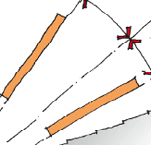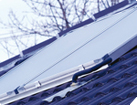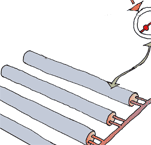Energy
Designing homes to conserve energy and use it efficiently, from sources that cause least environmental harm.
Collector panels
The efficiency and effectiveness of a solar water heating system will depend on the size and type of panels used, and on positioning them to maximise absorption of solar radiation.
On this page:
- Types of panels
- Sizing panels
- Positioning to maximise solar heat absorption
Types of panels
The two types of solar panel commonly available are:
- a flat plate collector
- an evacuated glass tube collector.
Panels incorporating a heat absorbing surface that transfers the heat to water pipes below are also available.
Flat plate collector
Flat plate solar panels are commonly used collectors. They have a metal plate with a dark-coloured coating to absorb heat.
Pipes under the plate contain water or some other fluid such as glycol, which absorbs heat and carries it to the water in the storage cylinder. A transparent cover, usually glass, admits solar radiation but stops it from escaping.
Flat plate panels have a life expectancy of about 20 years. Their construction is simple, with no moving parts, which means they’re easily repaired. They are relatively low cost and can supply water at temperatures up to 95ºC, though efficiency diminishes rapidly above 70ºC, so systems should be sized to avoid these sorts of temperatures.
Evacuated glass tube collector
Evacuated glass tube solar panels are made up of a number of glass tubes, typically 20 or more. Each tube has a vacuum to reduce convection and conduction heat losses. Evacuated tubes may contain an absorber plate connected to pipes through which a heat-absorbing fluid circulates or a heat pipe that contains an evaporating/condensing fluid to transfer heat.
Individual tubes sometimes fail but can be replaced at relatively low cost.
Sizing the panels
The size of the panel depends on the water storage capacity available and is typically based on a ratio of about 1 square metre of panel for each 50–70 litres of cylinder volume. Most panels commercially available are in the 3–8 m² range.
For a home with 3–4 occupants, a 200–275 litre storage cylinder with a 2.5–5 m² panel is recommended. For 5–6 occupants, the recommendation is for a 270–360 litre cylinder with a 3.75–6 m² panel area.
The expected output from a solar panel installed to maximise the amount of sun it receives is up to:
- 15 kWh/day on a sunny summer day
- 7 kWh/day on a sunny winter day (typically, water heating requires an energy input of 6–10 kWh/day).
Positioning to maximise solar heat absorption
The heating capacity of a solar water heating system is directly proportional to the amount of solar radiation absorbed, which depends on the following factors:
- Solar intensity: This is determined by the available solar radiation energy (kWh/m²) at a particular location. Solar intensity is generally higher at more northern latitudes, in summer, in clearer air and when there is less shading.
- Solar panel area: The larger the area, the more heat can be produced.
- Solar panel tilt angle: The optimum installed angle for solar absorption is perpendicular to the sun. Determined over the year, this is equal to the latitude (e.g. 41.2º in Wellington), although winter sun angles are lower and summer sun angles are higher. Panels can be optimised for winter water heating by increasing the angle over the latitude angle.
- Solar panel orientation: New Zealand sun is always in the north for all locations and all times of the year. Solar panels should be oriented to the north as much as possible. For maximum solar intensity, they should be oriented directly to geographic or solar north.
For further details on panel installation including tilt angles, see installation.

- Solar panel tilt angle
The tilt angle is the angle of the solar panels to the ground. The ideal angle will be different in summer and winter.
It may be necessary to change the location, tilt angle or orientation because of shading, aesthetic reasons, lack of available space, complex roof profile or lack of structural support from the building. However, the orientation should never be more than 20º from north, as solar absorption will reduce by more than 20% (reductions in heat gain continue the further the panel is from the geographic north point).
Update: 25 June 2013



